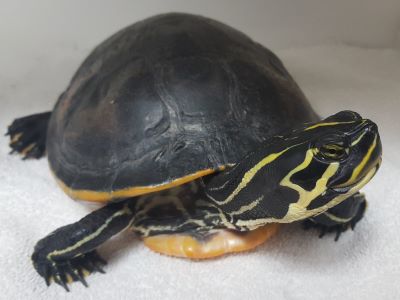
Because of World Turtle Day, May is an important month to raise awareness of the amazing turtles and tortoises we see at our clinic. We hope you enjoyed following us on Twitter @ExoticPetVets as we tweeted all month long about the yellow-bellied slider. But if you missed any of our tweets and would like a reference, here is a summary. Did you know?:
- The yellow-bellied slider (Trachemys scripta scripta) is a semi-aquatic turtle; meaning that while they spend much of their time in the water, they also need access to land where they can rest and bask in the sun.
- In the wild, yellow-bellied sliders are found wherever there are freshwater habitats available, including ponds, streams, lakes, marshes and ditches. They prefer being in shallow water with plenty of vegetation.
- Yellow-bellied sliders are endemic to the southeastern United States; specifically, their natural range includes southern Virginia to northern Florida.
- Introduced populations of yellow-bellied sliders have been found in other parts of the U.S. including Pennsylvania, New York, New Mexico, California and Arizona.
- It’s believed that because yellow-bellied sliders are commonly kept in captivity, these introduced populations are the result of pets who either escaped or were intentionally released.
- Yellow-bellied sliders are medium-sized turtles. They are considered sexually dimorphic because there are obvious physical differences between males and females.
- Adult female yellow-bellied sliders are noticeably larger than their male counterparts, reaching 8-to-13 inches (20-33 cms) in length. The males grow to between 5-to-9 inches (13-23 cms) in length.
- Male yellow-bellied sliders also have longer and thicker tails and the claws on the male’s forelimbs are longer than the female’s.
- Yellow-bellied sliders have oblong heads with turned-up snouts. They also have yellow stripes on their heads. There are also yellow stripes on their necks and legs, but these stripes are a bit thinner.
- Like other slider turtles, yellow-bellied sliders have rounded lower jaws, which is a feature that sets them apart from other turtle species who all have flat jaws.
- The upper part of the yellow-bellied slider’s shell (carapace) is usually deep olive or dark brown in colour with an all-over pattern in yellow. The bottom part of the shell (plastron) is mostly yellow with at least two sizable black spots.
- The yellow-bellied slider’s shell changes in appearance as the turtle ages. The yellow pattern on the carapace is pronounced in juveniles, but it fades and the turtle becomes darker and more difficult to identify as he ages.
- Yellow-bellied sliders are omnivorous, meaning they eat both plant and animal matter. Their diet in the wild includes insects, snails, small fish, tadpoles, leaves, fruits, algae and stems.
- Juvenile yellow-bellied sliders eat more animal matter. As they mature, they become more herbivorous.
- Yellow-bellied sliders are active during the day (diurnal). They eat mostly in the morning and spend the rest of the day basking in the sun.
- There is a reason why we chose the yellow-bellied slider as our Animal Of The Month for May. It’s because World Turtle Day is this Sunday. It is celebrated annually on May 23rd.
- Founded in 2000 by American Tortoise Rescue, World Turtle Day aims to raise awareness about the world’s turtles and tortoises, their environments and the threats they face from human activity.
- Yellow-bellied sliders have a long list of predators that include raccoons, foxes, skunks, alligators and otters.
- It’s no surprise that humans are a danger to yellow-bellied sliders for multiple reasons. People are known to shoot sliders basking in the sun. Motor vehicles, boat propellers and habitat loss are also human-created threats.
- Yellow-bellied sliders defend themselves by retracting their head and legs into their shells. If they are startled while basking on land, they will quickly slide into the water. They can also bite if they feel threatened.
- Yellow-bellied sliders can live between 25 and 30 years on average in the wild.
- If you are keen on having a yellow-bellied slider in your family, be prepared to make a very long-term commitment. With proper care, they can live an average of 40 years in captivity.
- Always wash your hands after handling any tortoise or turtle – including yellow-bellied sliders – because of concerns about the Salmonella bacterium.
- Generally speaking, yellow-bellied sliders should not be in families with young children who are prone to putting things in their mouths and don’t reliably wash their hands.

